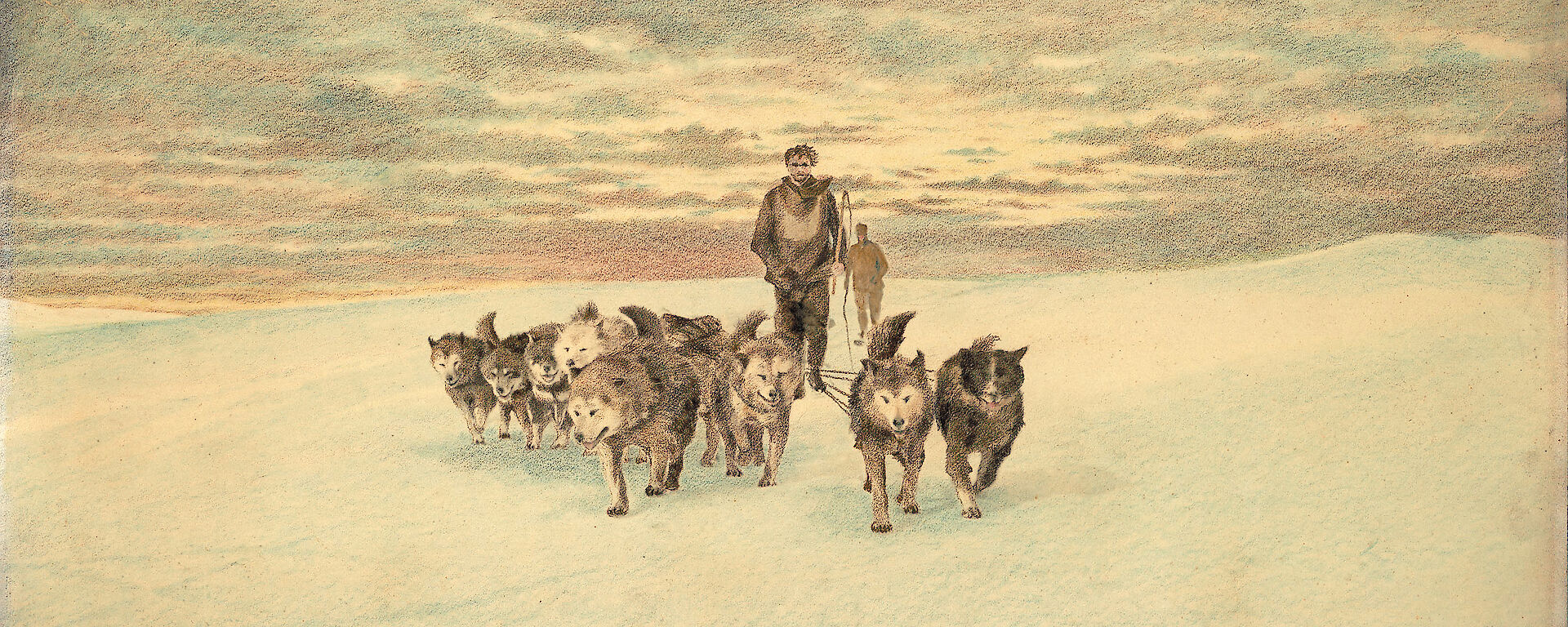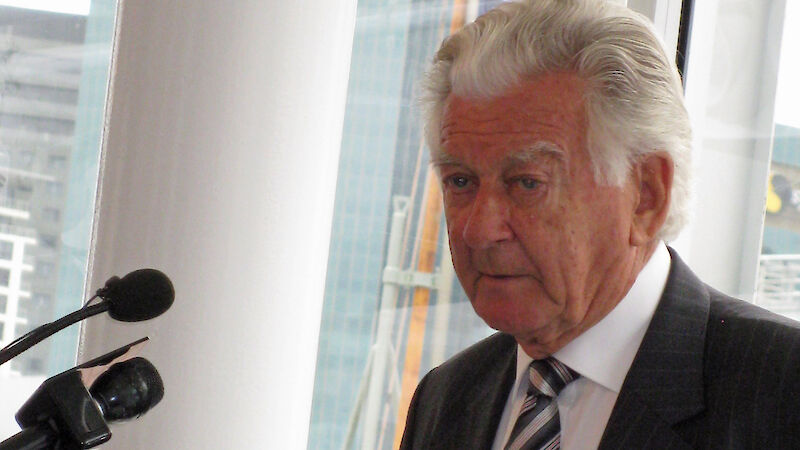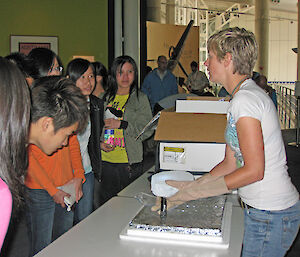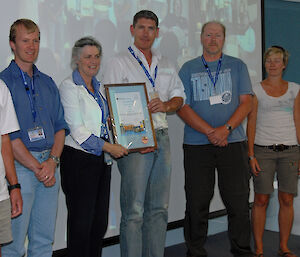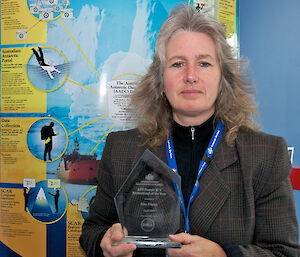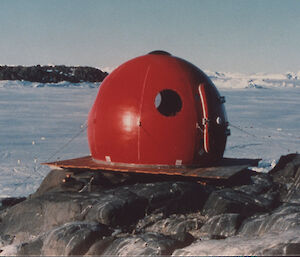New research fellowship honours Hawke Government
Former Australian Prime Minister Bob Hawke’s push, in 1989, to prevent mining in Antarctica and protect the Antarctic environment, has been recognised with a new Antarctic research fellowship and a new Antarctic building, both carrying his name.
The R.J.L. Hawke Fellowship in Antarctic Environmental Science will be awarded on the basis of excellence to new doctoral graduates for policy-relevant science aligned to the Australian Antarctic Strategic Plan.
A new accommodation building constructed at Wilkins Runway in the 2009¨C10 season has also been christened the Hon R. J. L. Hawke AC, Living Quarters, or ‘Hawke’s Hut'. The demountable building houses a mess, kitchen, laundry and bathroom facilities for runway crews.
The announcement of the fellowship and the building on 14 December 2009 marked the 20th anniversary of the Hawke Government’s leadership of an international push to reject mining in Antarctica. Environmental organisations also mounted an effective grassroots campaign at the time.
Federal Environment Protection Minister, Mr Peter Garrett, said the powerful alliance from the highest levels of the Hawke Cabinet, Non-Government Organisations and the community, in understanding the importance of Antarctica, deserved to be recognised and remembered.
Institute for Marine and Antarctic Studies
The new Institute for Marine and Antarctic Studies (IMAS), established on 1 January 2010, brings together the many strands of marine and Antarctic research being pursued in and around Hobart, to strengthen research links and exploit new research opportunities. IMAS brings together 200 staff and 140 graduate students from the Tasmanian Aquaculture and Fisheries Institute, the Institute for Antarctic and Southern Ocean Studies and some marine and Antarctic scientists from the University of Tasmania. The institute will also work closely with other research bodies including the Australian Antarctic Division and the Antarctic Climate and Ecosystems Cooperative Research Centre.
Rare Mawson publication
To celebrate the centenary of Sir Douglas Mawson's 1911-14 Australasian Antarctic Expedition, the Friends of Mawson, the Friends of the State Library of South Australia and the Mawson Collection Management Committee have published the periodic newspaper, Adélie Blizzard, which was produced by AAE expeditioners at Commonwealth Bay in 1912 and 1913. The newspaper was a collection of poetry, scientific results, observations, comedy and fiction, written by the expeditioners to keep boredom and depression at bay during the long, dark winters. Only five monthly issues were produced and none has been published before.
The 240 page full colour facsimile reproduction of the original, hand typed copy of Adélie Blizzard includes pencilled corrections by Mawson and Archie MacLean and additional rare paintings of Commonwealth Bay and Mawson by an artist on the relief ship, Aurora. The book is available in a limited leather-bound edition for $295 and a standard edition with a decorated cloth cover for $150. For an order form contact the Friends of the State Library of South Australia: phone (08) 8207 7255, email friends@slsa.sa.gov.au or visit their website.
Amendments to the Antarctic Treaty (Environment Protection) Act 1980
Amendments to Annex II to the Protocol on Environmental Protection to the Antarctic Treaty (Madrid Protocol), agreed at the 32nd Antarctic Treaty Consultative Meeting in 2009, will establish more stringent arrangements to protect Antarctic fauna and flora. Federal Environment Protection Minister, Peter Garrett, introduced the Antarctic Treaty (Environment Protection) Amendment Bill to Parliament on 10 February 2010 to implement the amendments into domestic law. Key amendments include: enabling the Minister to declare invertebrates as specially protected species and specifying restrictions on the taking of native invertebrates; tighter controls on permits allowing non-native organisms into the Antarctic; and stronger measures to guard against the accidental introduction of non-native organisms to Antarctica.
Polar Palooza
In November 2009 three Australian Antarctic Division scientists went 'on the road', presenting their work to thousands of people around Australia as part of a United States-based education and outreach initiative to raise awareness of the significance of polar science for planet Earth.
The initiative, known as ‘Polar Palooza’ (the name was inspired by the American Lollapalooza music festival), was supported by the US National Science Foundation (NSF) for the International Polar Year. The show travelled through North America in 2007 and 2008. In 2009, to coincide with the 50th anniversary of the Antarctic Treaty and as a legacy of the recently completed International Polar Year, NSF funded tours in other countries, including Australia.
The Australian Antarctic Division partnered with Polar Palooza and worked with the Australian National Maritime Museum in Sydney, SciTech in Perth, and Questacon in Canberra, to deliver a series of interactive, multimedia-rich learning ‘adventures’ (or presentations).
Our science ‘stars', Martin Riddle, Rob King and Tessa Vance, presented their work in marine biology, krill research and ice core analysis. The US researchers covered the effects of shrinking sea ice on penguins and seals, and polar bears in the Arctic, and included an Inupiat (Eskimo) who told the fascinating and concerning story of changing climate on his community in Barrow, Alaska.
The Antarctic Division team had an exhausting schedule of events with multiple and often back-to-back performances to audiences of primary school children and adults. At Questacon they also participated in what is reputed to be one of Australia’s biggest ever educational video conferences involving schools from most states.
Sally Chambers, Communications Manager, Australian Antarctic Division
Australia Day Awards
This year an individual Australia Day Award was presented to Bridget Payne for playing a key role in sharing knowledge and promoting teamwork across the Antarctic Division. A team award was presented to the Antarctic Division's glaciology research team, led by Dr Ian Allison, for taking a lead role in several major international collaborations of world class research, on the critical roles that Antarctic ice sheets and sea ice play in the global climate system. The team's work has contributed significantly to greater global understanding of trends in climate change and sea level rise.
The Australia Day Awards are provided to the Department of Environment, Water, Heritage and the Arts by the National Australia Day Council, and recognise the contributions of both individuals and teams in contributing to the achievement of the Department’s strategic plan objectives.
Environment and Safety update
Antarctic expeditioners can better avoid sunburn now with access to real time ultra-violet radiation data from Australia’s Antarctic and subantarctic stations and the Antarctic Division’s headquarters at Kingston . The data went live in December 2009 on the Australian Radiation Protection and Nuclear Safety Agency (ARPANSA) website. It is updated every minute. Long-term UV monitoring has been undertaken at the stations since 1988 using sensors located near the stations' medical facilities.
The Australian Antarctic Division’s Environmental Policy was recently reviewed and updated with one significant addition; all managers are now accountable for the environmental performance of their teams. In the past, environmental management tended to be seen as the province of specific environmental sections within the organization, but this change reflects the degree to which it has now been integrated into the mainstream work activities of all staff.
Annie Rushton, Environmental Management System Manager, Australian Antarctic Division
Information and Communication Technologies Award
Australian Antarctic Data Centre Manager, Kim Finney, received the inaugural Australian Public Service Leading Female ICT Professional of the Year Award in April. The award was developed by the Department of Finance and Deregulation and Dell Australia and recognises excellence across a number of categories centred on the attraction, retention and progression of female ICT talent within the Australian Public Service and from private and public sector organisations.
Kim was recognised for her extraordinary work for a number of different agencies and organisations including the Australian Antarctic Data Centre and former National Oceans Office. She played a lead role in establishing the Australian Ocean Data Centre Joint Facility, and developing successful major ICT funding proposals. In 2008 Kim was elected as the Chief Officer of the Scientific Committee on Antarctic Research (SCAR) Standing Committee on Antarctic Data Management. She drafted a Data and Information Strategy for SCAR, which is now being implemented across the organisation.
An apple in the Big Apple
An Antarctic ‘apple hut’ is a major feature in an international travelling exhibition about Antarctica showing at the American Museum of Natural History in New York until 2 January 2011. The Tasmanian-made apple huts, or Igloo Satellite Cabins as they're formally known, have been a feature of Australian Antarctic field life for 28 years (Australian Antarctic Magazine 14: 30–31, 2008). The exhibition, 'Race to the End of the Earth' recounts the contest between Scott and Amundsen to reach the South Pole in 1911-12. It also includes a section on Antarctic Science Today, showing how scientists live and work in Antarctica today.

